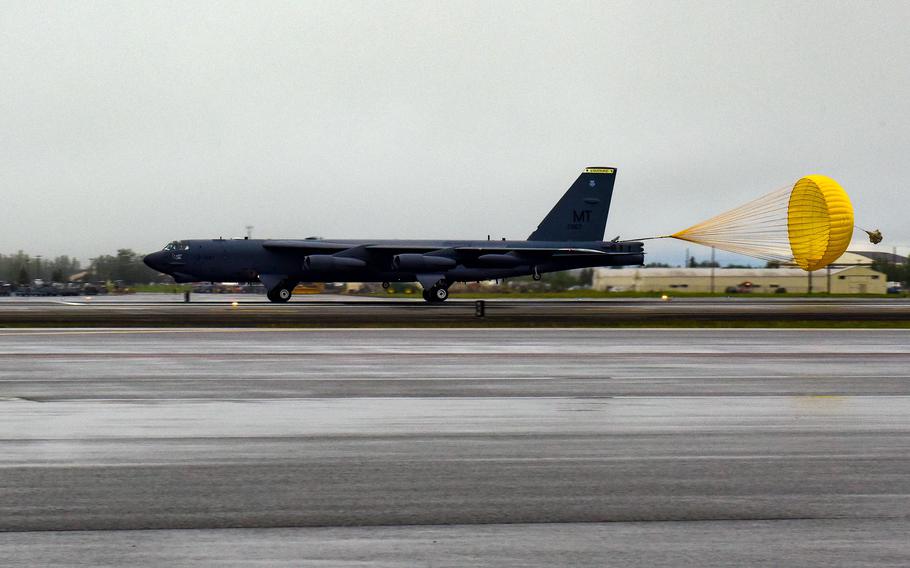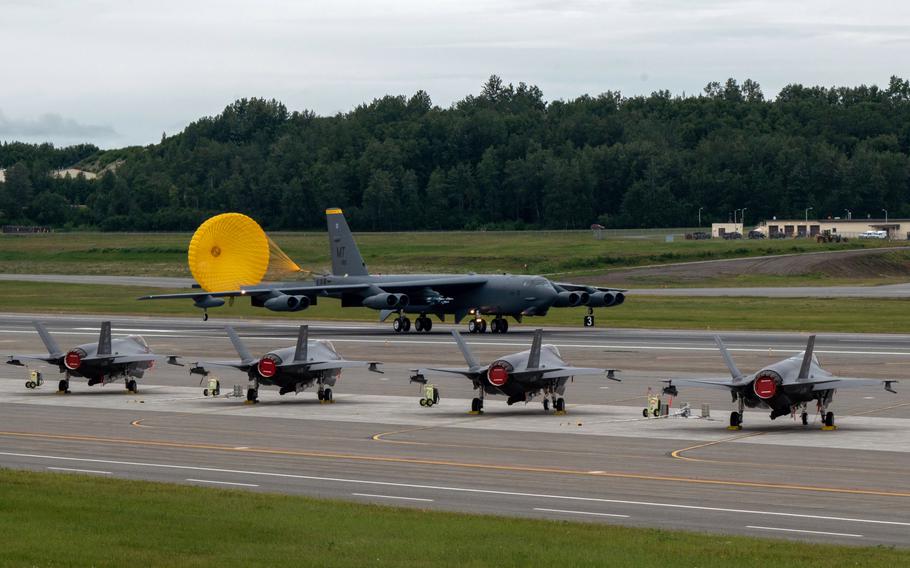
A drogue parachute helps a B-52H Stratofortress slow down upon landing at Joint Base Elmendorf-Richardson, Alaska, July 17, 2023. (Zachary Wright/U.S. Air Force)
The Air Force on Guam recently completed a $2.4 million restoration for a parachute drying tower that’s having a significant impact on bomber task force missions.
B-52H Stratofortress bombers deploy drogue parachutes — commonly called drag chutes — upon landing to minimize wear and tear on braking systems. But the chutes often pick up rocks and get wet “due to Guam’s humid and rainy environment,” according to 1st Lt. Ariana Wilkinson, a spokeswoman for the 36th Wing at Andersen Air Force Base.
Before the 90-foot, 200-pound chutes can be repacked and reused, airmen must remove the rocks and dry them with high-powered fans — previously a two-day process — she told Stars and Stripes in a recent email.
Restoration of Andersen’s seven-story drying tower — out of commission for 11 years after the Air Force deemed it unfit for use — adds an industrial furnace to the process. Drying the chutes now takes between 12 and 18 hours, Wilkinson said, adding that turnaround time has effectively “quadrupled.”
The B-52 is the only aircraft that uses drag chutes at Andersen, but the tower is capable of drying other parachutes as well.
“The reopening of it was another big win for the wing,” Air Force Lt. Col. Edwin Pratt, commander of the 36th Operations Support Squadron, said in an Oct. 4 news release about the upgrades.

A B-52H Stratofortress deploys its drogue chute as it lands at Joint Base Elmendorf-Richardson, Alaska, July 11, 2023. (Evan Lichtenhan/U.S. Air Force)
The Air Force has routinely sent B-52 and B-1 bombers to Guam from North Dakota and Louisiana since the task force missions began in 2018. The deployments typically last between two and six weeks.
The missions “demonstrate the credibility of U.S. forces to address a global security environment that is more diverse and uncertain than at any other time in recent history,” Pacific Air Forces said last week in a statement announcing the latest rotation.
“Our Bomber Task Force units out of Minot Air Force Base and Barksdale Air Force Base no longer need to be concerned that a pre-mature deployment of their parachute could have the potential of jeopardizing the next mission,” Pratt said.
The project is the result of a “multi-year collaborative effort” with the 36th Operations Support Squadron, Naval Facilities Engineering Systems and two contracting companies, Wilkinson added.
An undisclosed number of B-52s and airmen from Barksdale’s 2nd Bomb Wing arrived at Andersen on Oct. 20 to “actively train during operations and exercises while integrating alongside Allies and partners throughout the region,” the PACAF statement said.
That task force mission kicked off two days before a Barksdale-based B-52 participated in an unprecedented exercise with South Korea and Japan on Sunday.
The bomber joined two F-16 Fighting Falcons out of Osan Air Base, South Korea; two South Korean F-15K Slam Eagles; and two Japanese F-2s for an aerial drill that “demonstrated their security cooperation and solidarity,” the South Korean air force said in a news release that day.
Days earlier, the bomber became the first B-52 to touch down on the Korean Peninsula in at least 30 years.